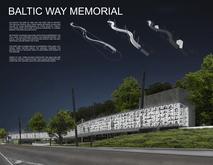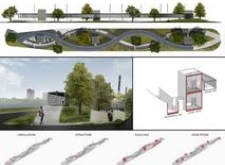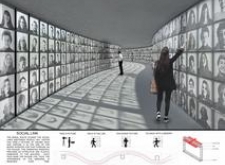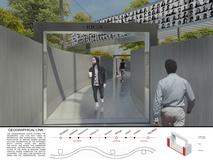5 key facts about this project
Functionally, the memorial is designed to facilitate a connection between the past and the present while fostering a sense of unity among visitors. The layout encourages movement and interaction, with pathways that meander through the site, symbolizing the human chain that inspired its creation. Visitors are guided along a carefully curated route that leads them through various sections of the memorial, each designed to enhance their understanding of the event it commemorates.
The design features key elements that include undulating pathways that mimic the flow of a human chain. This approach creates an immersive experience as visitors navigate through the memorial. There are areas dedicated to historical narratives, where information is presented through various mediums, including meaningful installations and photographs. This integration of personal stories ensures the memory of the event is honored while inviting contemporary dialogue.
The memorial uses a selection of materials that reflect both durability and a connection to the natural landscape of the Baltic region. Concrete forms the primary structural component, providing a strong and enduring foundation. Steel elements are introduced in various aspects of the design, supporting both the path and any cantilevered features, while glass is utilized to invite light and enhance visual connectivity with the surroundings. The inclusion of photographic panels allows for an interactive element where visitors can engage with the memorial on a personal level, contributing to its narrative through shared memories and experiences.
Notable within this project is the intention to create a communal space. Areas designed for gatherings and educational programming are integrated thoughtfully into the overall scheme, enabling the memorial not only to serve as a place of remembrance but also as a hub for cultural exchange and community activities. The landscape design complements the architecture, incorporating native plants that ground the memorial in its geographical context, thereby enhancing the visitor experience while fostering a sense of belonging to the space.
Unique to this project is its blend of architecture and community interaction, recognizing the importance of not just commemorating the past but also encouraging engagement with history through modern technology and personal storytelling. The design invites visitors to participate in the narrative of the memorial actively, prompting them to reflect on their histories and the collective memory of the Baltic peoples.
The Baltic Way Memorial effectively bridges historical remembrance with contemporary architectural principles, establishing a multifaceted space that serves various public functions while remaining anchored in its historical significance. It stands as a testament to the resilience of the Baltic states and their continuing journey toward unity and identity. For those interested in a deeper exploration of this noteworthy project, reviewing the architectural plans, sections, and designs will provide further insights into the thoughtful ideas that shape this commemorative space.
Visitors are encouraged to delve into the architectural ideas presented within this memorial to fully appreciate its design and the principles that guided its creation.


























